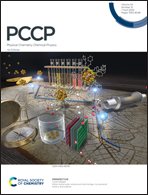An accurate many-body expansion potential energy surface for SiH2 (11 A′) using a switching function formalism
Abstract
An accurate many-body expansion potential energy surface for the ground state of SiH2 is reported. To warrant the correct behavior at the Si (1D) + H2 (X1Σ+g) dissociation channels involving silicon in the first excited Si (1D) and ground Si (3P) states, a switching function formalism has been utilized. A great deal of ab initio points based on aug-cc-pV(Q+d)Z and aug-cc-pV(5+d)Z basis sets are utilized at the multi-reference configuration interaction level using the full-valence-complete-active-space wave function as the reference. Subsequently the calculated energies are corrected via a many-body expansion method to extrapolate to the complete basis set limit. The topographic features of the novel many-body expansion global potential energy surface are studied in detail, showing a good agreement with the theoretical and experimental results in the literature. Moreover, the integral cross-section of the Si (1D) + H2 (X1Σ+g) → H (2S) + SiH (X2Π) reaction has been calculated using the time-dependent wave packet method, which provides support for the reliability of the title potential energy surface. This work can serve as the foundation for the study of Si (1D) + H2 (X1Σ+g) reaction kinetics, and for the construction of the larger multibody expansion potential energy surface of silicon/hydrogen containing systems.



 Please wait while we load your content...
Please wait while we load your content...